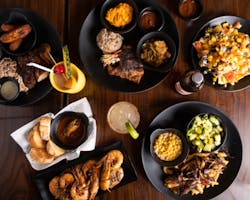Restaurant Microgrids in New Orleans Will Help People Do the Neighborly Thing
Now Garel is the proud owner of a solar microgrid – consisting of two Tesla Powerwalls and about 30 solar panels – at his Jamaican creole fusion restaurant, Afrodisiac NOLA, and he has expanded his goals for serving his community. During power outages, neighbors can gather at the restaurant and take advantage of a sanctuary with more space, big fans, a large patio and, of course, food.
“This multiplies everything we were doing before at my house,” he said.
Garel is among the first four New Orleans restaurant owners to receive a free solar microgrid as part of the Get Lit, Stay Lit program launched by the nonprofit organization Feed The Second Line. Get Lit, Stay Lit aims to equip 300 restaurants with microgrids and designate them places of refuge during hurricanes and storms. The effort recently received a $250,000 grant from the federal Department of Energy (DOE) through its Inclusive Energy Innovation Prize, which invests in community-led innovation and entrepreneurship programs in regions underserved by federal funding.
These efforts reflect the culture of the community, said Garel.
“We were just doing the neighborly thing when we were helping our neighbors,” he said. “That’s just who we are.”
Microgrid program grew out of Hurricane Ida’s wreckage
New Orleans, which has been wracked by numerous storms and experienced a 10-day outage during Hurricane Ida, has needed plenty of help, said Tinice Williams, executive director of Feed The Second Line.
“As crazy as it sounds, we’re used to storms and know how to fend for ourselves for a few days,” Williams said.
But Hurricane Ida’s 10-day outage left residents without air conditioning during extreme heat, and some residents died from heat exhaustion, she said. That prompted citizens to ask themselves what they could do differently, and Feed The Second Line’s Get Lit, Stay Lit project came to life.
“The first step is to be prepared and put the microgrids in the communities where people die, suffer and are left to fend for themselves,” Williams said. The program chose to provide microgrids to restaurants because the eateries are community hubs after storms.
The Get Lit, Stay Lit program was inspired by a residential microgrid project installed by Devin De Wulf, founder of Feed The Second Line, which aims to build a more equitable city, said Williams.
De Wulf’s microgrid operated through Hurricane Ida – which left 1.2 million people without power – and De Wulf transformed his home into a community sanctuary, said Williams. The people in his neighborhood who were most impacted by the hurricane couldn’t evacuate. They didn’t have transportation, couldn’t afford to leave or had medical issues, she said. Residents began charging their cell phones on his porch, restaurants stored food in his refrigerator, and he offered power to anyone with medical devices that needed electricity.
Microgrid recipients will put money back into the pot
The Get Lit, Stay Lit program has spent about $300,000 to date installing microgrids at the four restaurants and expects to get up to half of it back under clean energy incentives provided by the Inflation Reduction Act, said Williams. The organization has received a grant of $80,000 from Entergy, the local utility, plus funding from the city and individual donors. Going forward, it plans to pay for the microgrids by asking the restaurant owners with the systems to pay $200 a month for five years. The goal is to install 300 microgrids at restaurants – with each costing $60,000 to $90,000. Restaurant owners own the microgrids.
To date, Get Lit, Stay Lit is relying on an honor system. The restaurant owners have signed no contracts and haven’t paid a penny, Williams said. Get Lit, Stay Lit will use the recent DOE grant to collect energy use data from the microgrid recipients to get a feel for the energy cost savings. In addition, the organization is looking to hire another staff member.
“If we have 300 restaurants each putting $200 a month back into the pot, that’s $60,000 that we can use every month to fund another restaurant microgrid,” she said.
Get Lit, Stay Lit also has support behind it from the corporate side. Earlier this year, Entergy New Orleans announced it was granting $80,000 to help the program. The Honnold Foundation also is a supporter for solar microgrids at restaurants in the city.
Giving microgrids away in good faith
Right now, Williams is developing a memorandum of understanding for the microgrid recipients that spells out Get Lit, Stay Lit’s expectations. For example, they’re expected to ensure the systems are running properly. They should open up their restaurants during outages when it’s safe to do so, shouldn’t raise food prices during outages and should allow community members into their establishments, even if they’re not buying food.
“If we’re showing good faith, we expect them to show the same faith in return,” said Williams.
Along with installing the microgrids, Feed The Second Line has partnered with Louisiana Green Corps, which trains green workers, to create a training program for solar workers. Right now, most restaurant employees make $10 or $12 an hour. As solar installers, they can make about $20 an hour, said Williams.
For Williams, heading up this project and the prospect of doing the neighborly thing makes her happy.
“I have an overwhelming feeling of joy to know that we are trying to be prepared,” she said. “This is a sign of hope.”









